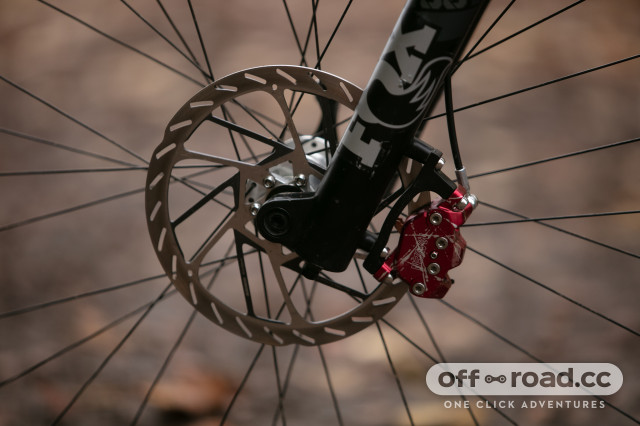The Maven is SRAM’s latest, biggest and burliest brake system that’s designed to slow the world’s fastest downhill riders. And that performance translates well to the average Joe as it delivers a serious amount of stopping power while remaining controlled and absolutely useable. It is a real story of compromise, however, as it’s a weightier brake, it’s pricy and it’s a bit of a pain to bleed. But there’s a lot more to the Maven than just its outrageous power.
SRAM Maven Ultimate brakes - Technical details
More is the name of the game with the Maven. Donning a bigger reservoir and a larger caliper with bigger pistons the brake is designed to produce more power – 50% more than the Code Ultimate. That said, SRAM has thrown in some clever touches to help achieve that with, perhaps, the most notable being the fact that it runs on mineral oil, rather than DOT fluid.
That’s a move I’m happy with simply because it’s a safer fluid. It’s friendly to the paintwork and kinder to the skin. SRAM’s move to mineral oil was made possible through the inclusion of new piston seals that are more resistant to higher temperatures. As such, it’s said that the Maven doesn’t suffer the downsides that the use of mineral oil poses, namely its lower boiling point.
Temperature management sits at the forefront of the Maven’s design, and so it should. Producing more power also produces more heat but this brake uses that temperature to its advantage. SRAM admits that it might take longer to warm up but, the Maven should maintain its optimum operating temperature while the closed caliper design helps retain heat, rather than dissipate it entirely. The result is a more consistent brake as it’s not constantly warming and cooling during the length of a descent. However, the caliper does feature two heat ducts to help the brake regulate its temperature.
The caliper is built for stiffness, and rather than using the standard two-bolt design (we’re talking about the bolts that join both sides of the caliper), the Maven uses four. As with many things in cycling, excess flex is the enemy, and flex in a brake caliper can reduce braking power. These extra bolts are added to combat that while providing a solid feel at the lever. The pads are then loaded into the bottom of the caliper to help achieve that stiffer design.
There are two 19.5mm pistons paired with two 18mm pistons. These have been added to translate more force into the pads for even more power.
SRAM claims that the Maven’s requires 32% less input force to achieve the same braking power as the Code and this should reduce fatigue. That’s thanks to the ratio engineered into the larger reservoir but also the new SwingLink built into the lever. Built especially for this brake, it’s said that this new link results in a leverage rate that changes as the lever is pulled deeper into its stroke. Essentially, it’s progressive so the more you pull, the more power the brake kicks out.
The SRAM Maven is available in Ultimate, Silver, and Bronze models, and we’ve received it in the former but as part of the limited-edition Expert Box that comes with everything you’ll ever need to fettle with the brake. That includes one 180mm rotor, two 200mm, and a 220mm rotor. There’s also a neat pouch for them to live in, with caliper adapters, a full bleed kit, and a bottle of mineral oil. There’s also a pair of organic (resin) and sintered (metallic) pads thrown in.
A pair of non-limited edition Mavens without the box of stuff will set you back £320 an end.
SRAM Maven Ultimate brakes - Installation
When installing the brakes, I did have a bit of luck shoving the cable through my internally routed frame free-hand - I can’t help but show off a bit there - but that’s where the generally good times ended. Now, this brake uses the excellent Bleeding Edge system for bleeding but because the brake is larger, there’s more space for air to hide in the system. As such, it’s a bit of a pain to bleed. I bled this brake about four times before I was properly happy. It’s just a case of patience and moving the brake around as it is bled to free hidden bubbles.
Aligning the rotor isn’t as straightforward either. Unlike any other caliper, ignoring Magura's, it’s hard to see down into the caliper from the top. But it is possible – just take your time.
SRAM Maven Ultimate brakes - Performance
Although the setup is a little finicky compared to more conventional brakes and a bigger and perhaps more intimidating-looking brake, the Maven is surprisingly easy to live with but as with everything, it’s a compromise. For one, it’s not a light brake at 351g for the complete front brake but again, it’s bigger and offers more of everything.
And yes, it delivers more power. There’s no two ways about it and I must admit, when jumping off a Code-equipped bike onto one setup with Mavens, I’ve nearly flung myself over the bars. The Maven does require a bit of time to get to grips with but once it’s all figured out, it offers serious performance in more ways than brute power.
While tonnes of power is certainly attractive and useful, the main benefit that the Maven provides is how much power it summons versus how little effort you put into the lever. Because of that, arm pump and fatigue have never been a concern. That also means that there’s plenty of modulation at the brake’s disposal all while having the full strength of the power in reserve as a get-out-of-jail-free card, after poorly chosen braking points and such.
But that modulation and easily attained power makes it a very usable and approachable brake. Yes, it takes a moment to figure out how it delivers that power but the Maven is a product that’s produced a new level of confidence, allowing me to brake later knowing that I can slow down sufficiently.
And when the trail gets steep, the Maven provides a sense of control I’ve not had with any other brake. During sections where I would commit to passenger mode, the power, modulation, and communication of the brake boost control, gave me the option to manage speed through dodgy bits of trail. So long as there’s traction available.
That is after dialling in the rotor size, however. SRAM recommends that riders new to the Maven brake should start using the smaller rotor sizes. I ignored this and ran 200mm discs at both ends, and, as a result, I found the rear to lock up very quickly, and it wasn’t nearly as controlled as I would have liked. Moving to a 180mm rotor granted me much better modulation while still benefiting from the greater power.
SRAM shows no shame in stating that this brake takes a little bit to warm up and the brand’s true. With metallic pads, it took a couple of corners worth of braking for the Maven to give me its full performance. After which, power and lever feel are mighty consistent. I’m not riding downhill WC length trails but fade isn’t something I’ve had to worry about.
That’s with resin pads too and I’ve run them in the cooler weather to surprisingly great effect, even when it’s been sopping wet outside. As expected, they don't take as much time to warm, meaning that the Maven’s power is more accessible earlier into a descent.
Aside from the weight and the interesting bleeding, downsides are few but I’ve found the Maven to be particularly noisy and that’s on my own bike and other test bikes. The resin pads do calm this down for a bit but for the performance on offer, a bit of noise is worth it.
SRAM Maven Ultimate brakes - Verdict
The Maven is almost a first of its kind - a heavy-duty brake built for consistent and easily attained power. There is Magura’s recent Gustav Pro but this brake isn’t exactly built for more power, as the German brand claims to be content with the power its brake lineup delivers. Instead, it’s built for consistency. A pair of Magura Gustav Pros will set you back £600 and they don’t come with all the bits that the SRAM Maven Ultimate Expert Box.
The SRAM Maven Ultimate isn’t without compromise. It’s weighty, noisy and fairly pricey, but if you’re happy to ignore these points, well, the Maven's abundance of control, modulation and power sets it apart from anything else on the market.

















Add comment